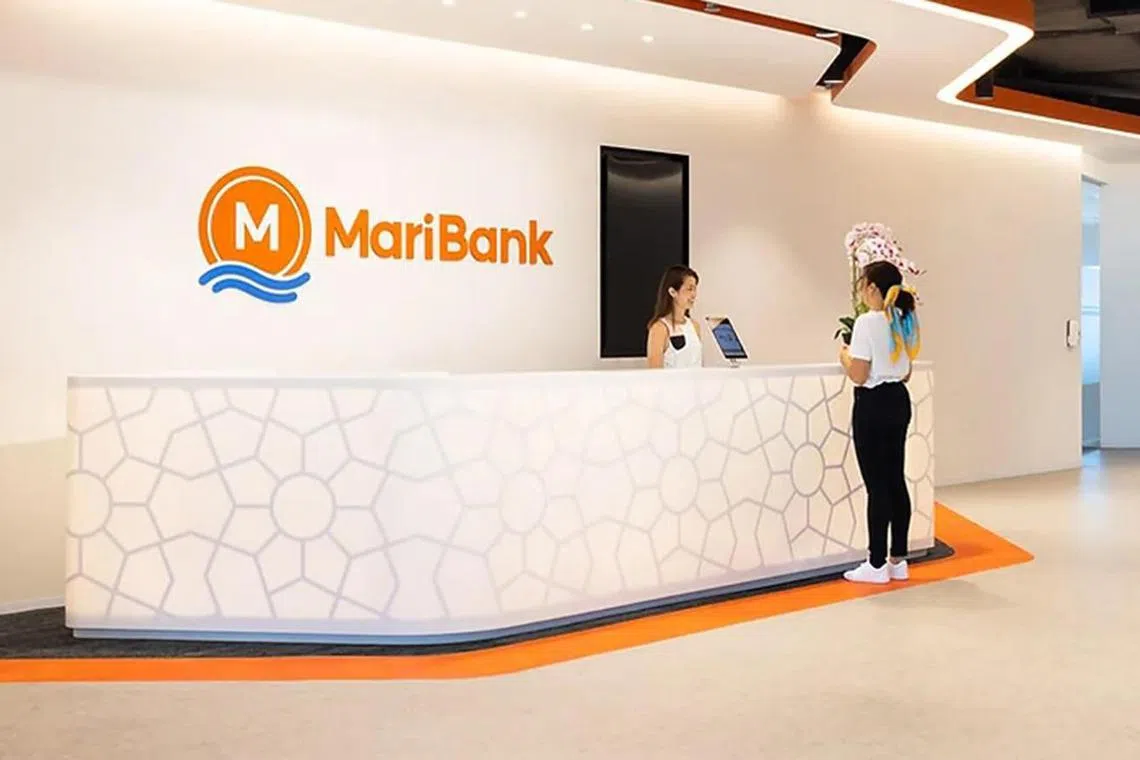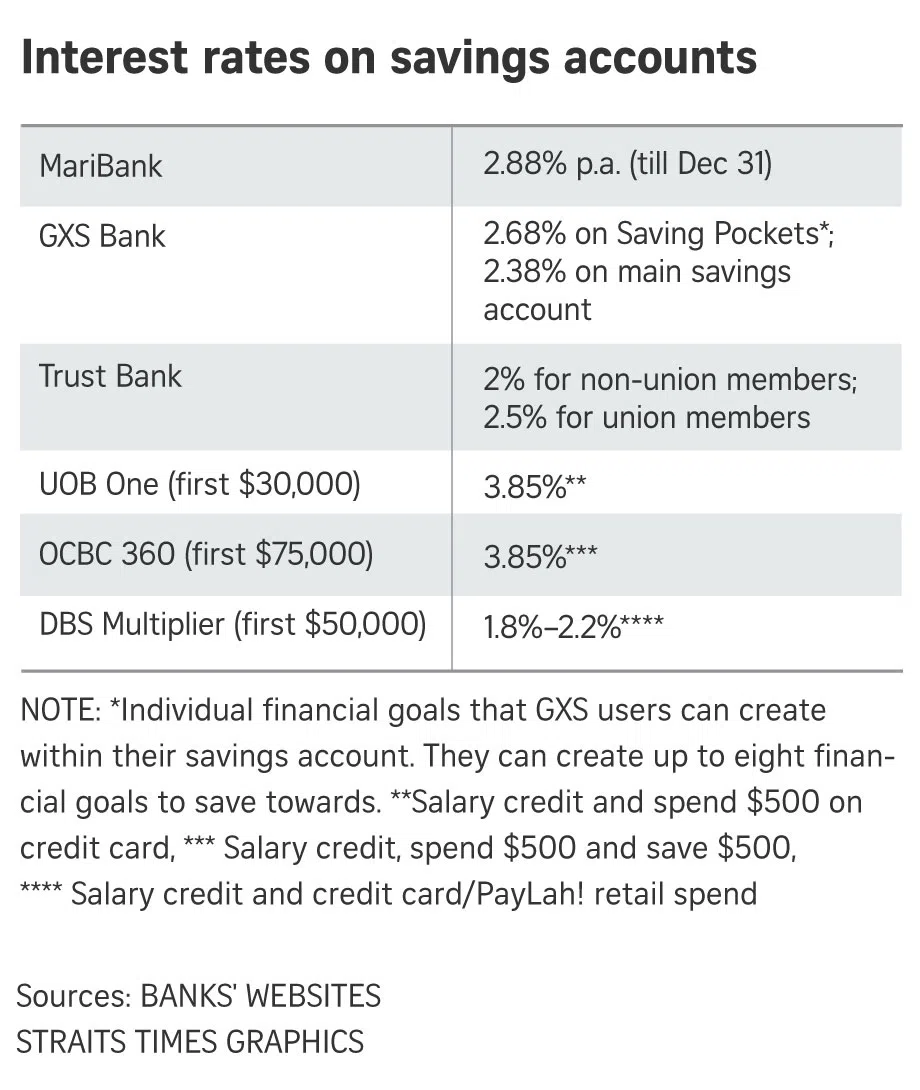MariBank raises interest rate on savings account to 2.88% as digital banks seek to draw customers
Sign up now: Get ST's newsletters delivered to your inbox

MariBank’s promotional offer of 2.88 per cent per annum for savings accounts ends on Dec 31.
PHOTO: MARIBANK
Follow topic:
SINGAPORE – The digital banking unit of gaming and e-commerce group Sea now has the highest interest rate on savings accounts among the three digital banks in Singapore after it raised its rate on Monday.
MariBank’s 2.88 per cent promotional offer is also higher than what DBS Multiplier customers can get when they credit their salary and card spend, but lower than what UOB One and OCBC 360 customers are getting.
The MariBank offer ends on Dec 31, when it will revert to the base rate of 2.5 per cent, which its customers have been getting since the digital bank launched in March.
Rival digital bank GXS cut its deposit rate in its Saving Pockets to 2.68 per cent a year
Associate Professor Jan Ondrus from the Asia-Pacific campus of Essec Business School said all banks, including digital ones, use interest rates to gain new customers.
Financial advisory director Shawn Yap, 46, has accounts with GXS and Trust and is mulling over opening one with MariBank soon, “just to try out (as) 2.88 per cent is a good deal”.
Prof Ondrus said digital banks hope that once customers like Mr Yap open an account, they are less likely to leave after the promotional offer ends, especially if they have had a good experience and do not have to pay any fees to stay on.
The banks can then cross-sell other products or services, he added.
However, Fitch Asia-Pacific financial institutions director Willie Tanoto said it is difficult and unsustainable to compete solely on interest rates because the incumbent banks have “much better developed deposit franchises”.
Fitch said local banks DBS, OCBC and UOB accounted for 65 per cent of all Singapore-dollar deposits as at the end of 2022, with combined deposits of around $500 billion.
UOB and OCBC can also offer relatively higher interest rates on their flagship savings accounts while DBS generally dishes out relatively lower rates because it has a bigger deposit base from its POSB franchise.
UOB One pays a total interest rate of 3.85 per cent for the first $30,000 in the account, provided account holders credit their salary and spend at least $500 a month on a UOB card.
The OCBC 360 account also gives a total interest rate of 3.85 per cent for the first $75,000 if customers credit their salary, and save and spend at least $500 a month.
The DBS Multiplier pays between 1.8 per cent and 2.2 per cent on the first $50,000 in the account, if customers credit their salary and spend.

Depositors can take their money to any bank they want, so in times of market stress, the big three lenders will benefit from a flight to quality, Fitch said.
Mr Zennon Kapron, director of fintech research and consulting firm Kapronasia, said Singapore’s PayNow infrastructure makes it easier for an already fickle customer base to move their money.
Mr Yap said: “These are emergency funds that are liquid, and can be shifted and spread around.”
The digital banks will first have to find ways to grow their customer base and then improve deposit stickiness and build loyalty, said Mr Tanoto.
He added that they are caught in a Catch-22 situation: They need to “invest significantly in deposit-gathering to build a critical mass of profitable assets” but they do not yet have the “recurring profits” to fund the growth.
There is an initial period where the digital banks will have to “burn cash”, Mr Tanoto said.
Prof Ondrus warned that they also need to keep costs down in their pursuit for customers.
GXS Bank and MariBank announced in July that they will be open to the public and will raise their deposit limits
Like at the incumbent banks, these deposits will be insured up to $75,000 per person by the Singapore Deposit Insurance Corporation.
Once they have built up scale, Prof Ondrus said, the digital banks can introduce extra services like insurance or investment options.
But he is more cautious on loan solutions or products that he sees as riskier.
“In the short term, the digital banks might not earn a lot from loans. They need to have enough deposits, which will act as a cushion against the risks,” he added.
A MariBank spokesman told The Straits Times that the bank is expanding its suite of personal banking solutions to include an investment solution.
“This will complement our savings solution and provide our customers with more simple and fuss-free options to grow their wealth,” the spokesman added.
GXS Bank has a personal loan offer that lets customers borrow as little as $200,
It said it will launch a debit card in the coming months that will give rewards and cashback when customers spend using their savings accounts.
Trust Bank already has a credit card, a personal loan solution and insurance products that are underwritten and issued by insurer Income.
Mr Kapron said Trust has leveraged well on the FairPrice ecosystem to grow its footprint, adding: “Everyone needs to buy groceries regularly.”
The bank had attracted over $1 billion in deposits by early May
Trust Bank said recently that it is now the “world’s fastest growing digital bank by market share”.
More than 600,000 customers – 12 per cent of the Singapore market – have signed up for an account since it was launched a year ago, the bank added.
Mr Kapron suggested the other players could build an ecosystem around their digital bank.
The MariBank spokesman said it is looking to introduce more integrated services linked to its Sea parent.
“Customers can top up their ShopeePay wallet directly from the MariBank app.
“In the months to come, customers can expect more seamless payment methods on Shopee with MariBank,” he added.
Prof Ondrus said most people will not fully replace their main bank with a fully digital one in the near term, but he noted that digital players have an opportunity to make banking more inclusive with lower fees and user-friendly technology.
“Their strength is agility. They can roll out new features faster to meet customer needs,” he added.
“Now, it will be up to them to exploit this advantage by being as innovative as possible while conservatively managing the risks.”


